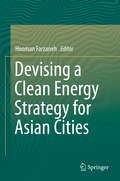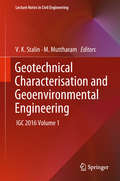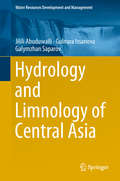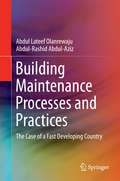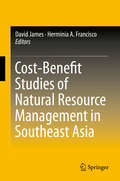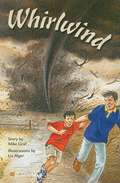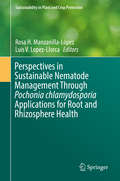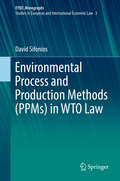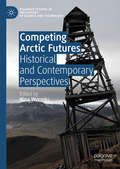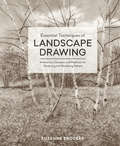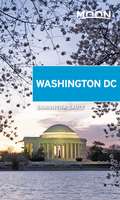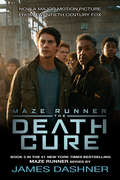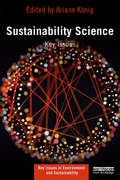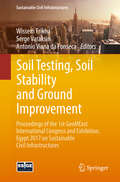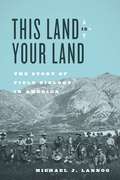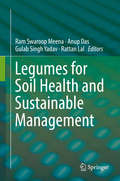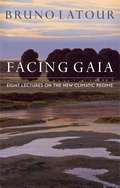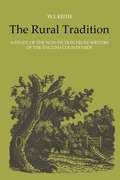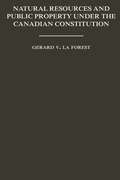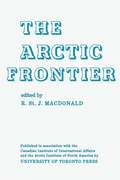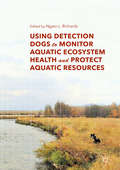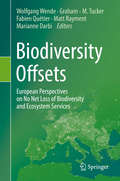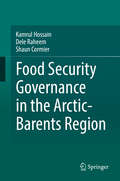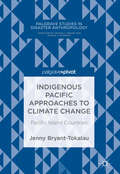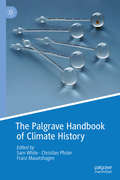- Table View
- List View
Devising a Clean Energy Strategy for Asian Cities
by Hooman FarzanehThis book capitalizes on two hot topics: the Low Carbon Emission Development Strategies and climate change in Asian cities. There is resurgence in making policies to investigate more aspects of the energy-environment spectrum for the global energy market in the future. This book helps the policy makers and researchers to understand which actions should be taken to reduce the environmental impacts of economic activities in different regions in Asia. The clean energy strategy proposed in this book refers to the development and implementation of policies and strategies that simultaneously contribute to addressing climate change and solving local environmental problems, which also have other development impacts. It provides insights to a wide audience on successful ways to promote, design and implement the clean energy policies in Asian cities. To determine the global actions, it is necessary to make breakthroughs by promoting further research and to present scenarios that achieve Low Emission Development Strategies (LEDS) goals without dependence upon fossil fuels. The scenarios and case studies discussed in this book are helpful to plan for the SDGs, where various objectives have to be achieved at the same time. The UN 2030 development agenda needs innovative planning to achieve multiple goals with limited resources and generate synergy among sectors. This book will be one of the first books available on this subject.
Geotechnical Characterisation and Geoenvironmental Engineering: IGC 2016 Volume 1 (Lecture Notes in Civil Engineering #16)
by V. K. Stalin M. MuttharamThe book comprises selected proceedings of the 2016 annual conference of the Indian Geotechnical Society. The technical papers presented on the theme “Geotechnical Characterisation and Geoenvironmental Engineering” highlight the modified geotechnical properties of soil admixed industrial waste and also the characteristics of soil with different pore fluid under varying test conditions. The major topics covered are (i) characterisation of soils, rocks and synthesised materials and (ii) geoenvironmental engineering and behaviour of unsaturated soil. This book will prove a valuable reference for researchers and practicing engineers alike.
Hydrology and Limnology of Central Asia (Water Resources Development and Management)
by Gulnura Issanova Jilili Abuduwaili Galymzhan SaparovThis book highlights the development of lake systems and water reservoirs as well as the impact of climate change on water resources in Central Asian countries. It provides information on the genesis of lake basins, physical and chemical properties of water in lakes, and the hydrological regimes (water balance and fluctuation levels) of lakes of Central Asia and Xinjiang. The book is useful for scientists and researchers whose work focuses on lakes and the use of natural resources, irrigation, hydropower and water supply, as well as for students and planners.
Building Maintenance Processes and Practices: The Case of a Fast Developing Country
by Abdul Lateef Olanrewaju Abdul-Rashid Abdul-AzizThis book is designed to be an inclusive for the best practice approach to building maintenance management, where the processes, procedures and operational systems meet a high standard of professional and academic competence. It offers a different perspective on building maintenance management by presenting the schematic building maintenance value chain model and it's implementation in Malaysian university buildings. The findings show an improvement to building performance, lower maintenance cost, building sustainability and increased maintenance service user satisfaction. The learning outcomes and summaries provided for each chapter and the extensive use of tables and figures add to the readability of the text. Though the book is based on data from Malaysia, it is useful for a much wider audience, and the informal writing style makes it an interesting reference source. This book is valuable for readers who are practitioners, professionals and for academic institutions that offer courses in the building field, including architecture, quantity surveying, civil engineering, building and facility management, property management, real estate. It will also be of interest to governments and others involved in the construction industry.
Cost-Benefit Studies of Natural Resource Management in Southeast Asia
by David James Herminia A. FranciscoThis book applies cost-benefit analysis techniques in the management of environment and natural resources in developing countries of the Southeast Asian region and presents a compendium of studies conducted by researchers supported by the Economy and Environment Program for Southeast Asia (EEPSEA). It emphasizes the close relationship between the environment and natural resources and economic development in such countries, addressing a wide range of problems that can be understood using economic evaluation techniques. General guidelines for conducting economic appraisals are provided, with the case studies illustrating how they can be applied in a developing country context. Cost-Benefit Analysis Application in Environmental and Natural Resource Management in Southeast Asia serves as essential reading for teachers, researchers, students and practitioners in environmental and natural resource economics, economic development and key issues facing policymakers in the Southeast Asian region.
Whirlwind (Rigby PM Plus Blue (Levels 9-11), Fountas & Pinnell Select Collections Grade 3 Level Q)
by Mike GrafOne windy day, when Matt and Dad are flying Matt's kite, Whirlwind, they see some storm clouds approached. The sky grows darker, and thunder rumbles in the distance. A small piece of cloud starts spinning down towards the ground. Dad realizes that this is no ordinary storm. "That's a full-blown tornado!" he cries.
Perspectives in Sustainable Nematode Management Through Pochonia chlamydosporia Applications for Root and Rhizosphere Health
by Rosa H. Manzanilla-López Luis V. Lopez-LlorcaThis volume reviews our current knowledge and novel research areas on Pochonia chlamydosporia, a cosmopolitan fungus occurring in soils as a saprophyte yet capable of colonizing the rhizosphere of crops as an endophyte and behaving as a parasite of eggs of plant-parasitic nematodes. The book is divided into six sections containing 18 chapters, starting with a historical background chapter, followed by 16 chapters, each contributed by experts, concerning those key aspects necessary to work with this biocontrol agent in a multidisciplinary treatise. Topics covered include systematics, biology, nematode-fungus interactions, nematode management strategies, secondary metabolites, and other methods including more novel research areas such as molecular, –omics, plant growth enhancement and endophytic abilities of P. chlamydosporia. The final chapter deals with the future perspectives of P. chlamydosporia research.
Environmental Process and Production Methods (European Yearbook of International Economic Law #3)
by David SifoniosThis book examines the conditions under which PPM measures may be adopted under WTO law de lege lata and de lege ferenda. It analyses in detail the complex case law in this field and its evolution in the last 25 years, as well as the many doctrinal debates around PPM measures and their relevance in the light of the evolution of case law, both under the GATT and the TBT Agreement. Further, it also suggests an original approach to the interpretation of the relevant provisions of the GATT and the TBT Agreement in the context of PPM measures. The PPM issue has been one of the most debated topics in the trade and environment debate. Even though the US-Shrimp case showed that PPM measures are not prohibited per se under the GATT, many questions remain unanswered when it comes to the precise conditions under which environmental PPM measures are justifiable under WTO law, for example in the field of trade measures relating to climate change mitigation efforts, natural resources management policies and biodiversity conservation measures.
Competing Arctic Futures: Historical and Contemporary Perspectives (Palgrave Studies in the History of Science and Technology)
by Nina WormbsThis edited collection explores how narratives about the future of the Arctic have been produced historically up until the present day. The contemporary deterministic and monolithic narrative is shown to be only one of several possible ways forward. This book problematizes the dominant prediction that there will be increased shipping and resource extraction as the ice melts and shows how this seemingly inevitable future has consequences for the action that can be taken in the present. This collection looks to historical projections about the future of the Arctic, evaluating why some voices have been heard and championed, while others remain marginalised. It questions how these historical perspectives have shaped resource allocation and governance structures to understand the forces behind change in the Arctic region. Considering the history of individuals and institutions, their political and economic networks and their perceived power, the essays in this collection offer new perspectives on how the future of the Arctic has been produced and communicated.
Essential Techniques of Landscape Drawing: Master the Concepts and Methods for Observing and Rendering Nature
by Suzanne BrookerThis beginner's guide to drawing in graphite pencil uses step-by-step exercises to teach fundamental methods for rendering all aspects of the natural landscape, with additional lessons on using charcoal, colored pencil, pastel, and other media.Following in the footsteps of author, artist, and art instructor Suzanne Brooker's previous title The Elements of Landscape Oil Painting, this book pairs the most universally-pursued topic for artists (drawing) with the popular subject matter of the natural landscape. Brooker breaks down landscapes into their various elements--including the earth, water, air, and trees--to convey how the fundamentals of drawing are applied to capture each aspect. Using the graphite pencil as her baseline instrument, Brooker provides you with step-by-step lessons that help you improve your rendering skills and re-create the beauty of the world outdoors. Examples from art history and contemporary masters supplement these lessons. The end result is a drawing instruction book that provides artists with everything they need to render landscapes no matter their skill level.
Moon Washington DC (Travel Guide)
by Samantha SaultHistory, politics, and the world's best free museums: DC is a bustling powerhouse of a city. From strolling the National Mall to hobnobbing at happy hour, get to know the capital with Moon Washington DC.Navigate the Neighborhoods: Follow one of our guided neighborhood walks through Penn Quarter, Dupont Circle, U Street, Adams Morgan, and moreExplore the City: Snap the perfect photo of the Washington Monument, tour the U.S. Capitol, and explore the incredible Smithsonian museums like the African American History Museum or the Newseum. Catch a whiff of the fragrant cherry blossoms in the spring, rent a boat and paddle along the Potomac, or shop the boutiques in GeorgetownGet a Taste of the City: Chow down on a late-night half-smoke at Ben's Chili Bowl or grab brunch and a new book from Busboys and Poets. Enjoy Michelin-starred seafood at a waterfront restaurant, order up a Chesapeake crab cake, and enjoy the city's diversity of authentic fare from Ethiopia, Afghanistan, the Philippines, and moreBars and Nightlife: Watch a groundbreaking performance at the Woolly Mammoth Theatre Company, catch a live band at the 9:30 Club, or dance to a DJ set at the Black Cat. Sip scotch where former presidents once did, try a five-course cocktail tasting menu, or kick back with a beer and fries at a quintessential DC dive barLocal Advice: Local journalist Samantha Sault shares her love of the nation's capital Strategic, Flexible Itineraries including the three-day best of DC, a weekend with kids, and more, plus day trips to Old Town Alexandria, Annapolis, Easton, and Shenandoah National ParkTips for Travelers including where to stay and how to navigate the Metro, plus advice for international visitors, LGBTQ travelers, seniors, travelers with disabilities, and families with childrenMaps and Tools like background information on the history and culture of DC, full-color photos, color-coded neighborhood maps, and an easy-to-read foldout map to use on the goWith Moon Washington DC's practical tips and local insight, you can experience the city your way.Expanding your trip? Check out Moon Maryland, Moon Virginia, or Moon Chesapeake Bay. Visiting more of America's best cities? Try Moon Boston or Moon Chicago.
The Death Cure: The Death Cure - The Official Graphic Novel Prelude (The Maze Runner #3)
by James DashnerThomas knows that Wicked can't be trusted, but they say the time for lies is over, that they've collected all they can from the Trials and now must rely on the Gladers, with full memories restored, to help them with their ultimate mission. It's up to the Gladers to complete the blueprint for the cure to the Flare with a final voluntary test. What Wicked doesn't know is that something's happened that no Trial or Variable could have foreseen. Thomas has remembered far more than they think. And he knows that he can't believe a word of what Wicked says. The time for lies is over. But the truth is more dangerous than Thomas could ever imagine. Will anyone survive the Death Cure? <P><P> <i>Advisory: Bookshare has learned that this book offers only partial accessibility. We have kept it in the collection because it is useful for some of our members. Benetech is actively working on projects to improve accessibility issues such as these.</i>
Sustainability Science: Key Issues (Key Issues in Environment and Sustainability)
by Jerome Ravetz Ariane König<p>Sustainability Science: Key Issues is a comprehensive textbook for undergraduates, postgraduates, and participants in executive trainings from any disciplinary background studying the theory and practice of sustainability science. Each chapter takes a critical and reflective stance on a key issue or method of sustainability science. Contributing authors offer perspectives from diverse disciplines, including physics, philosophy of science, agronomy, geography, and the learning sciences. <p>This book equips readers with a better understanding of how one might actively design, engage in, and guide collaborative processes for transforming human-environment-technology interactions, whilst embracing complexity, contingency, uncertainties, and contradictions emerging from diverse values and world views. Each reader of this book will thus have guidance on how to create and/or engage in similar initiatives or courses in their own context. <p>Sustainability Science: Key Issues is the ideal book for students and researchers engaged in problem and project based learning in sustainability science.</p>
Soil Testing, Soil Stability and Ground Improvement: Proceedings of the 1st GeoMEast International Congress and Exhibition, Egypt 2017 on Sustainable Civil Infrastructures (Sustainable Civil Infrastructures)
by Wissem Frikha Serge Varaksin Antonio Viana da FonsecaEarthwork projects are critical components in civil construction and often require detailed management techniques and unique solution methods to address failures. Being earth bound, earthwork is influenced by geomaterial properties at the onset of a project. Hence, an understanding of the in-situ soil properties is essential. Slope stability is a common problem facing earthwork construction, such as excavations and shored structures. Analytical methods for slope stability remain critical for researchers due to the mechanical complexity of the system. Striving for better earthwork project managements, the geotechnical engineering community continues to find improved testing techniques for determining sensitive properties of soil and rock, including stress-wave based, non-destructive testing methods. To minimize failure during earthwork construction, past case studies and data may reveal useful lessons and information to improve project management and minimize economic losses. This volume is part of the proceedings of the 1st GeoMEast International Congress and Exhibition on Sustainable Civil Infrastructures, Egypt 2017.
This Land Is Your Land: The Story of Field Biology in America
by Michael J. LannooField biology is enjoying a resurgence due to several factors, the most important being the realization that there is no ecology, no conservation, and no ecosystem restoration without an understanding of the basic relationships between species and their environments—an understanding gleaned only through field-based natural history. With this resurgence, modern field biologists find themselves asking fundamental existential questions such as: Where did we come from? What is our story? Are we part of a larger legacy? In This Land Is Your Land, seasoned field biologist Michael J. Lannoo answers these questions and more in a tale rooted in the people and institutions of the Midwest. It is a story told from the ground up, a rubber boot–based natural history of field biology in America. Lannoo illuminates characters such as John Wesley Powell, William Temple Hornaday, and Olaus and Adolph Murie—homegrown midwestern field biologists who either headed east to populate major research centers or went west to conduct their fieldwork along the frontier. From the pioneering work of Victor Shelford, Henry Chandler Cowles, and Aldo Leopold to contemporary insights from biologists such as Jim Furnish and historians such as William Cronon, Lannoo’s unearthing of American—and particularly midwestern—field biologists reveals how these scientists influenced American ecology, conservation biology, and restoration ecology, and in turn drove global conservation efforts through environmental legislation and land set-asides. This Land Is Your Land reveals the little-known legacy of midwestern field biologists, whose ethos and discoveries have enabled us to preserve and understand not just their land, but all lands.
Legumes for Soil Health and Sustainable Management
by Rattan Lal Ram Swaroop Meena Anup Das Gulab Singh YadavSustainable management of soils is an important global issue of the 21st century. Feeding roughly 8 billion people with an environmentally sustainable production system is a major challenge, especially considering the fact that 10% of the world’s population at risk of hunger and 25% at risk of malnutrition. Accordingly, the 68th United Nations (UN) general assembly declared 2016 the “International Year of Pulses” to raise awareness and to celebrate the role of pulses in human nutrition and welfare. Likewise, the assembly declared the year 2015 as the “International Year of Soils” to promote awareness of the role of “healthy soils for a healthy life” and the International Union of Soil Science (IUSS) has declared 2015-2024 as the International Decade of Soils. Including legumes in cropping systems is an important toward advancing soil sustainability, food and nutritional security without compromising soil quality or its production potential. Several textbooks and edited volumes are currently available on general soil fertility or on legumes but‚ to date‚ none have been dedicated to the study of “Legumes for Soil Health and Sustainable Management”. This is important aspect, as the soil, the epidermis of the Earth (geoderma)‚ is the major component of the terrestrial biosphere. This book explores the impacts of legumes on soil health and sustainability, structure and functioning of agro-ecosystems, agronomic productivity and food security, BNF, microbial transformation of soil N and P, plant-growth-promoting rhizobacteria, biofertilizers, etc. With the advent of fertilizers, legumes have been sidelined since World War II, which has produced serious consequences for soils and the environment alike. Therefore, legume-based rational cropping/soil management practices must support environmentally and economically sustainable agroecosystems based on (sequential) rotation and intercropping considerations to restore soil health and sustainability. All chapters are amply illustrated with appropriately placed data, tables, figures, and photographs, and supported with extensive and cutting-edge references. The editors have provided a roadmap for the sustainable development of legumes for food and nutritional security and soil sustainability in agricultural systems, offering a unique resource for teachers, researchers, and policymakers, as well as undergraduate and graduate students of soil science, agronomy, ecology, and the environmental sciences.
Facing Gaia Eight Lectures on the New Climatic Regime
by Bruno LatourThe emergence of modern sciences in the seventeenth century profoundly renewed our understanding of nature. For the last three centuries new ideas of nature have been continually developed by theology, politics, economics, and science, especially the sciences of the material world.
The Rural Tradition: A Study of the Non-Fiction Prose Writers of the English Countryside (The Royal Society of Canada Special Publications)
by William Keith'There is probably no single quality or characteristic – besides love of the countryside – that must inevitably distinguish a rural writer,' notes W.J. Keith. However, 'what distinguishes rural writing that belongs to literature from that belonging to natural history, agricultural history, etc., is, as Richard E. Haymaker has observed, the writer's "means of revealing Nature as well as describing her"...In the final analysis the rural essayist paints neither landscapes nor self-portraits; instead he communicates the subtle relationship between himself and his environment, offering for our inspection his own attitudes and his own vision. We may be asked to look or to agree, but more than anything else we are invited to share. Ultimately, then, the best rural writing may be said to provide us, in a phrase adapted from Robert Langbaum, with a prose of experience.' Keith argues that non-fiction rural prose should be recognized as a distinct literary tradition that merits serious critical attention. In this book he tests the cogency of thinking in terms of a 'rural tradition,' examines the critical problems inherent in such writing, and traces significant continuities between rural writers. Eleven of the more important and influential writers from the seventeenth century to modern times come under individual scrutiny: Izaak Walton, Gilbert White, William Cobbett, Mary Russell Mitford, George Borrow, Richard Jefferies, George Sturt/'George Bourne', W.H. Hudson, Edward Thomas Williamson, and H.J. Massingham.In examining these writers within the context of the rural tradition, Keith rescues their works from the literary attic where they have too often been relegated as awkward misfits. When studied together, each throws fascinating light on the others and is seen to fit into a loose but nonetheless discernible 'line.'
Natural Resources and Public Property Under the Canadian Constitution (The Royal Society of Canada Special Publications)
by Gerard La ForestThe controversy aroused by the Supreme Court's decision on offshore mineral rights emphsizes the importance of the public domain in the workings of the Canadian constitution. Public property is important to the provinces not only for its revenues, but also because it provides them with a powerful instrument for control of their economic and political destinies and strengthens their position in relation to federal authorities. The provisions of the British North America Act and other constitutional instruments relating to natural resources and public property are examined thoroughly in this series of lectures given to doctoral systems at the Faulte de droit of the Universite de Montreal. Professor La Forest studies ownership of mines and minerals, navigable waters, public harbours, fisheries and Indian lands, as well as the currently controversial offshore mineral rights. He notes the political imlications of the partition of proprietary rights and explores the areas of conflict between the federal and provincial governments. Also included is a discussion of the power of expropriation, and, because public property involves public monies, lending and spending powers receive attention.In these lectures, Professor La Forest traces public domain in Britain from the time when the monarch controlled all the land, to his surrender of this control to parliament in return for a civil list, and to the similar surrender to the legislatures of the British North American colonies in connection with the struggle of responsible government.The collection of lectures is essential reading for any serious student of the constitution and will be very useful to all who are interested in the increasingly important law of natural resources in Canada.
The Arctic Frontier (The Royal Society of Canada Special Publications)
by Ronald MacDonaldThe idea of the Arctic Ocean as a mediterranean sea is a shock to those of us—and that includes most of us—who cannot shake ourselves free of the Mercatorean vision. Yet this theme is repeated by many of the eminent ocntributors to this volume: as Michael Marsden states, "IT is difficult to impress upon the public and industry at large that the most essential quality of the Arctic is not cold, or gold, or polar bears, but a central position in the world community." This book, then, is about the North as a frontier, and about Canada's relations with the world beyond that frontier. It is about the Arctic community of which Canada is one of the major members, along with the Soviet Union, the United States, Denmark, Iceland, and Norway. It is also an exercise in perspective. Canadians have long been aware of the significance of their Atlantic and Pacific frontiers and of the implications of their Southern frontier. This volume points out that Canada is not a three-sided country. While it does not neglect the military importance of the Arctic, it endeavours to widen the scope of interest. But it does not present the familiar arguments about the surpassing importance of the Arctic. It deflates as well as inflates. Its purpose is to assess as precisely as possible the implications of the Arctic frontier, not to induce either visions or nightmares. It is intended not only for Canadians but for all those who are interested in the polar regions or in the shape of the world at large. The papers in this volume were assembled in collaboration by the Canadian Institute of International Affairs and the Arctic Institute of North America.
Using Detection Dogs to Monitor Aquatic Ecosystem Health and Protect Aquatic Resources
by Ngaio L. RichardsThis book is about the varied range of emerging applications using specially trained detection dogs to monitor and protect aquatic ecosystems, animals, plants and related resources. Featuring contributions from those at the forefront of converging disciplines ranging from canine training, ecological and biological monitoring, water resource management, law enforcement, and eco-toxicology, it addresses everyone already immersed in these or related fields, and anyone seeking to gain a broader understanding of them. Chapters cover several common themes including monitoring presence/absence through biological and ecological surveys; maintaining and evaluating water quality; law enforcement and anti-poaching initiatives; public education, awareness and compliance; standards and best practices; optimal uses of dogs in relation to and in conjunction with other available tools and pragmatic considerations for selecting and working with dogs and handlers. The aim of the book is to stimulate new ideas, promote the sharing and dissemination of information and findings - and, ideally, to catalyze new and innovative partnerships, to strengthen the preservation and conservation of our aquatic heritage.
Biodiversity Offsets: The European Perspective On No Net Loss Of Biodiversity And Ecosystem Services
by Wolfgang Wende Fabien Quétier Matt Rayment Marianne Darbi Graham TuckerThis book deals with the new concept of biodiversity offsets. The aim of offsetting schemes is to achieve no let loss or even net gain of biodiversity. Offsets obey a mitigation hierarchy and reflect the precautionary and polluter-pays principle in regard to project impacts. Readers gain insights into current debates on biodiversity policies, with top experts outlining theoretical principles and the latest research findings. At the same time the focus is on practical application and case studies. Today there is a lively international discussion among practitioners and scientists on the optimal legal framework, metrics and design of habitat banks to ensure the success of biodiversity offsets and to minimise the risks of failure or misuse. Contributing to the debate, this volume presents the activities and practices of biodiversity offsetting already implemented in Europe in selected EU member states, and the lessons that can be learnt from them. Readers may be surprised at how much experience already exists in these countries. A further aim of the book is to offer grounded insights on the road ahead, and foster a more intensive and fruitful discussion on how offsetting can be extended and improved upon, so that it becomes a key and effective component of Europe’s biodiversity conservation policy framework.
Food Security Governance in the Arctic-Barents Region
by Kamrul Hossain Dele Raheem Shaun CormierFood Security Governance in the Arctic-Barents Region provides a multidisciplinary perspective on the major food security and safety challenges faced in the Arctic region. The authors address existing gaps in current knowledge of the coordination and implementation of legal framework and policy that affects the Arctic. The volume is unique in its focus on the Barents region, an area of northern Europe containing Norway, Sweden, Finland and Russia. The region has a population of approximately 5.2 million, including indigenous and non-indigenous peoples. The authors offer a balanced and systemic review of the role of traditional foods in this region, along with an overview of the regulatory tools and institutions that govern food security. Food security and safety in the –Arctic-Barents region is connected to and impacted by transformations from both inside and outside the area. Climate change, globalization and human activities affect the availability, accessibility, and affordability of food. The result of these transformations has an impact on the food security and safety for both indigenous and non-indigenous individuals and communities. The authors, by highlighting these challenges, reveal the importance of having harmonized policies and legal tools in place in order to strengthen food security and safety in the Barents region. The book forms part of the main outcome of the Academy of Finland’s ongoing project on Human Security as a promotional tool for societal security in the Arctic: Addressing Multiple Vulnerability to its Population with Specific Reference to the Barents Region (HuSArctic). Researchers, policy makers, and other stakeholders will find the book to be an important contribution to the promotion of policies and strategies on food security.
Indigenous Pacific Approaches to Climate Change: Pacific Island Countries
by Jenny Bryant-TokalauThis book explores how Pacific Island communities are responding to the challenges wrought by climate change—most notably fresh water accessibility, the growing threat of disease, and crop failure. The Pacific Island nations are not alone in facing these challenges, but their responses are unique in that they arise from traditional and community-based understandings of climate and disaster. Knowledge sharing, community education, and widespread participation in decision-making have promoted social resilience to such challenges across the Pacific. In this exploration of the Pacific Island countries, Bryant-Tokalau demonstrates that by understanding the inter-relatedness of local expertise, customary resource management, traditional knowledge and practice, as well as the roles of leaders and institutions, local “knowledge-practice-belief systems” can be used to inform adaptation to disasters wherever they occur.
The Palgrave Handbook of Climate History
by Sam White Christian Pfister Franz MauelshagenThis handbook offers the first comprehensive, state-of-the-field guide to past weather and climate and their role in human societies. Bringing together dozens of international specialists from the sciences and humanities, this volume describes the methods, sources, and major findings of historical climate reconstruction and impact research. Its chapters take the reader through each key source of past climate and weather information and each technique of analysis; through each historical period and region of the world; through the major topics of climate and history and core case studies; and finally through the history of climate ideas and science. Using clear, non-technical language, The Palgrave Handbook of Climate History serves as a textbook for students, a reference guide for specialists and an introduction to climate history for scholars and interested readers.
